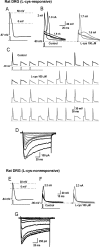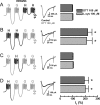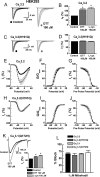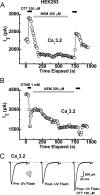Reducing agents sensitize C-type nociceptors by relieving high-affinity zinc inhibition of T-type calcium channels
- PMID: 17670971
- PMCID: PMC6673068
- DOI: 10.1523/JNEUROSCI.1800-07.2007
Reducing agents sensitize C-type nociceptors by relieving high-affinity zinc inhibition of T-type calcium channels
Abstract
Recent studies have demonstrated an important role for T-type Ca2+ channels (T-channels) in controlling the excitability of peripheral pain-sensing neurons (nociceptors). However, the molecular mechanisms underlying the functions of T-channels in nociceptors are poorly understood. Here, we demonstrate that reducing agents as well as endogenous metal chelators sensitize C-type dorsal root ganglion nociceptors by chelating Zn2+ ions off specific extracellular histidine residues on Ca(v)3.2 T-channels, thus relieving tonic channel inhibition, enhancing Ca(v)3.2 currents, and lowering the threshold for nociceptor excitability in vitro and in vivo. Collectively, these findings describe a novel mechanism of nociceptor sensitization and firmly establish reducing agents, as well as Zn2+, Zn2+-chelating amino acids, and Zn2+-chelating proteins as endogenous modulators of Ca(v)3.2 and nociceptor excitability.
Figures








Similar articles
-
The endogenous redox agent L-cysteine induces T-type Ca2+ channel-dependent sensitization of a novel subpopulation of rat peripheral nociceptors.J Neurosci. 2005 Sep 21;25(38):8766-75. doi: 10.1523/JNEUROSCI.2527-05.2005. J Neurosci. 2005. PMID: 16177046 Free PMC article.
-
Genetic alteration of the metal/redox modulation of Cav3.2 T-type calcium channel reveals its role in neuronal excitability.J Physiol. 2016 Jul 1;594(13):3561-74. doi: 10.1113/JP271925. Epub 2016 May 7. J Physiol. 2016. PMID: 26931411 Free PMC article.
-
Redox modulation of T-type calcium channels in rat peripheral nociceptors.Neuron. 2001 Jul 19;31(1):75-85. doi: 10.1016/s0896-6273(01)00338-5. Neuron. 2001. PMID: 11498052
-
Targeting Ca2+ channels to treat pain: T-type versus N-type.Trends Pharmacol Sci. 2004 Sep;25(9):465-70. doi: 10.1016/j.tips.2004.07.004. Trends Pharmacol Sci. 2004. PMID: 15559248 Review.
-
Is there a role for T-type calcium channels in peripheral and central pain sensitization?Mol Neurobiol. 2006 Dec;34(3):243-8. doi: 10.1385/MN:34:3:243. Mol Neurobiol. 2006. PMID: 17308355 Review.
Cited by
-
T-type calcium channels in chronic pain: mouse models and specific blockers.Pflugers Arch. 2014 Apr;466(4):707-17. doi: 10.1007/s00424-014-1484-4. Epub 2014 Mar 4. Pflugers Arch. 2014. PMID: 24590509 Review.
-
I-II loop structural determinants in the gating and surface expression of low voltage-activated calcium channels.PLoS One. 2008 Aug 20;3(8):e2976. doi: 10.1371/journal.pone.0002976. PLoS One. 2008. PMID: 18714336 Free PMC article.
-
Neuropathic pain: role for presynaptic T-type channels in nociceptive signaling.Pflugers Arch. 2013 Jul;465(7):921-7. doi: 10.1007/s00424-012-1211-y. Epub 2013 Jan 16. Pflugers Arch. 2013. PMID: 23322114 Review.
-
Structural determinants of the high affinity extracellular zinc binding site on Cav3.2 T-type calcium channels.J Biol Chem. 2010 Jan 29;285(5):3271-81. doi: 10.1074/jbc.M109.067660. Epub 2009 Nov 23. J Biol Chem. 2010. PMID: 19940152 Free PMC article.
-
Role of voltage-gated calcium channels in ascending pain pathways.Brain Res Rev. 2009 Apr;60(1):84-9. doi: 10.1016/j.brainresrev.2008.12.021. Epub 2008 Dec 31. Brain Res Rev. 2009. PMID: 19162069 Free PMC article. Review.
References
-
- Bhave G, Gereau RW., IV Posttranslational mechanisms of peripheral sensitization. J Neurobiol. 2004;61:88–106. - PubMed
-
- Cardenas CG, Del Mar LP, Scroggs RS. Variation in serotonergic inhibition of calcium channel currents in four types of rat sensory neurons differentiated by membrane properties. J Neurophysiol. 1995;74:1870–1879. - PubMed
-
- Chen CC, Lamping KG, Nuno DW, Barresi R, Prouty SJ, Lavoie JL, Cribbs LL, England SK, Sigmund CD, Weiss RM, Williamson RA, Hill JA, Campbell KP. Abnormal coronary function in mice deficient in alpha1H T-type Ca2+ channels. Science. 2003;302:1416–1418. - PubMed
Publication types
MeSH terms
Substances
Grants and funding
LinkOut - more resources
Full Text Sources
Other Literature Sources
Miscellaneous
